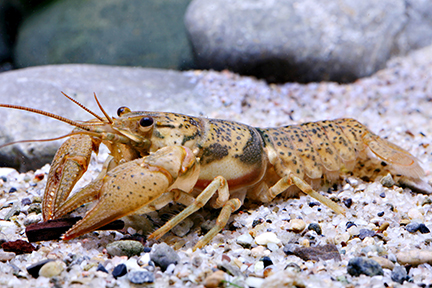JEFFERSON CITY – The U.S. Fish and Wildlife Service has listed the Big Creek crayfish and the St. Francis River crayfish as threatened under the Endangered Species Act. The two lobster-like crustaceans are found within the St. Francis River watershed in southeastern Missouri. The final rule and supporting information are available online in the Federal Register reading room.

Big Creek crayfish. Photo courtesy of Chris Lukhaup/Missouri Department of Conservation.
The primary threat to the species is the woodland crayfish, a non-native invertebrate that was discovered within the St. Francis River tributary in 1984. Since its introduction, the woodland crayfish has spread throughout a large portion of the upper St. Francis River drainage and has caused the range of the Big Creek and St. Francis crayfishes to contract. Their abundance has been substantially reduced in areas invaded by the woodland crayfish.
Degraded water quality is also a threat to the species. The crayfishes occur in an area of Missouri where lead mining was once a major activity. Although most mining activity has stopped, waste from mining operations is still present, resulting in the contamination of fish and other aquatic life. Other water quality issues, such as sedimentation, also threaten the species.
The Service also finalized a special rule under section 4(d) of the Endangered Species Act, which allows incidental (unintentional) take of the species under certain circumstances. Additionally, the agency is proposing critical habitat for the two species. Critical habitat is an area that contains habitat features that are essential for the survival and recovery of a listed species. A critical habitat designation imposes no requirements on state or private actions where no federal funding, permits or approvals are required.
Critical habitat for the two crayfishes includes all streams occupied by the crayfishes. These streams include the Upper St. Francis River upstream of Wappapello Dam and tributaries in Iron, Madison, St. Francois, Washington, and Wayne counties, Missouri.
The mission of the U.S. Fish and Wildlife Service is working with others to conserve, protect and enhance fish, wildlife, plants and their habitats for the continuing benefit of the American people. We are both a leader and trusted partner in fish and wildlife conservation, known for our scientific excellence, stewardship of lands and natural resources, dedicated professionals and commitment to public service. For more information on our work and the people who make it happen, visit http://www.fws/gov.
